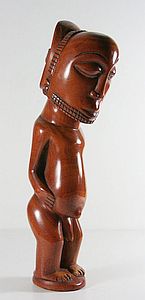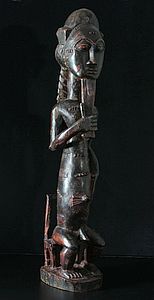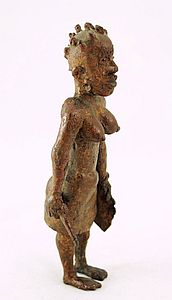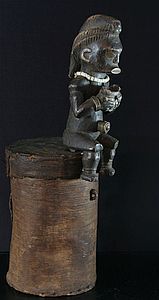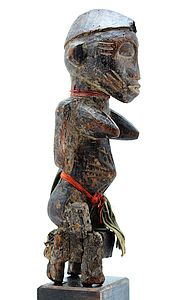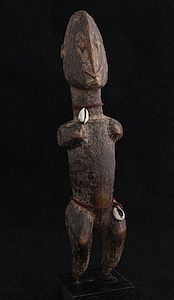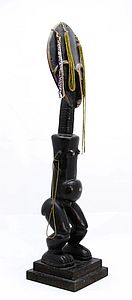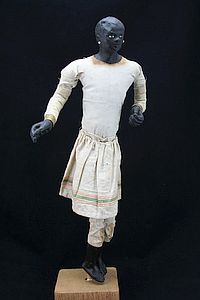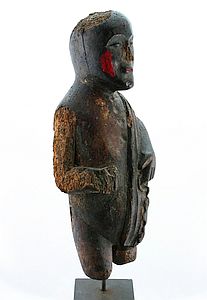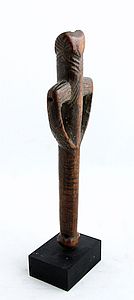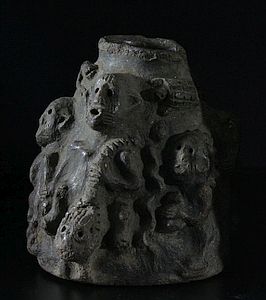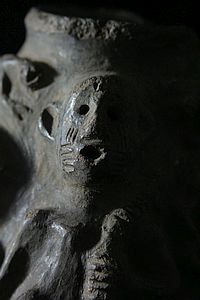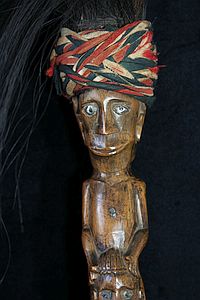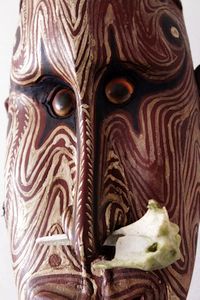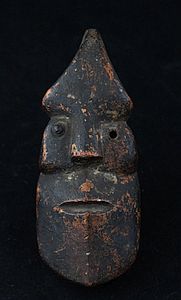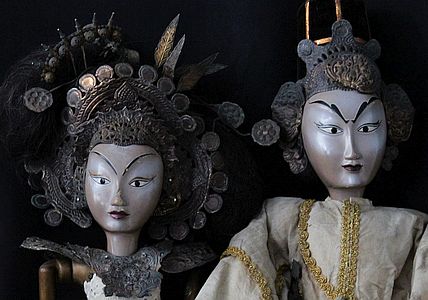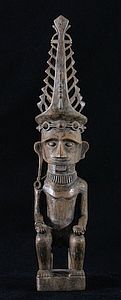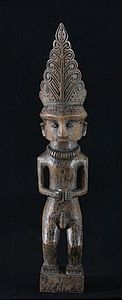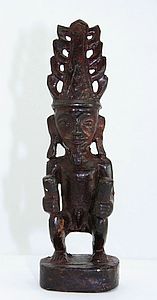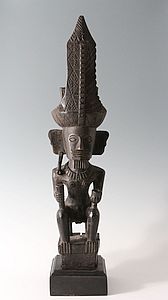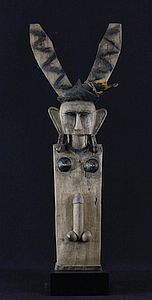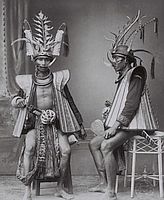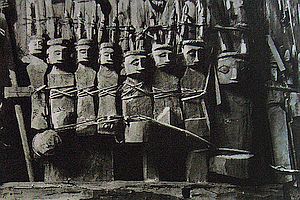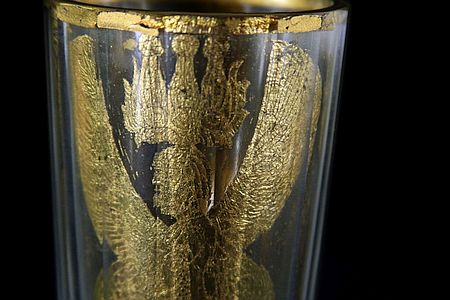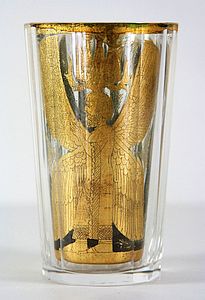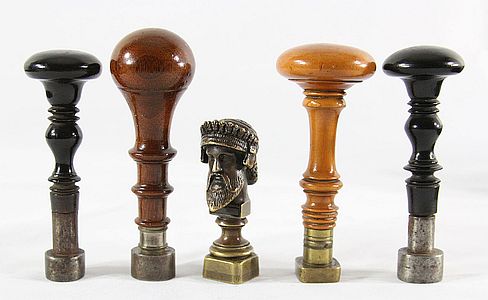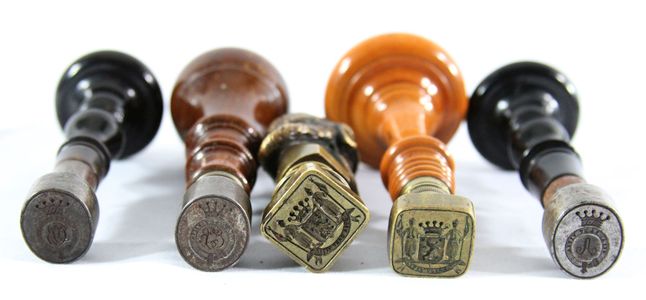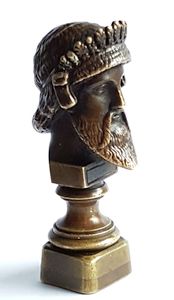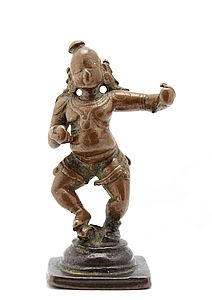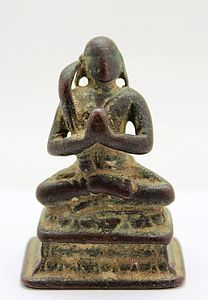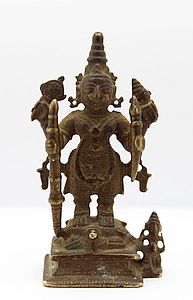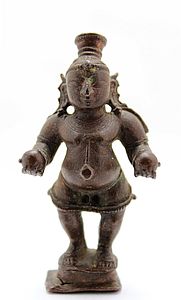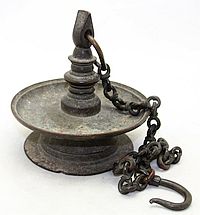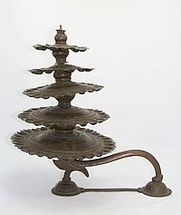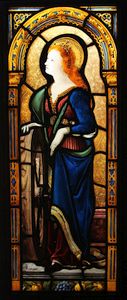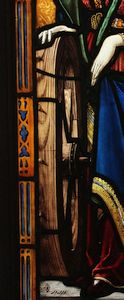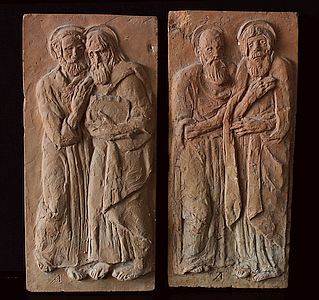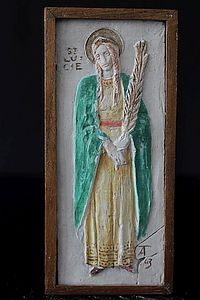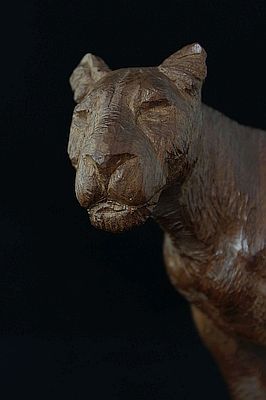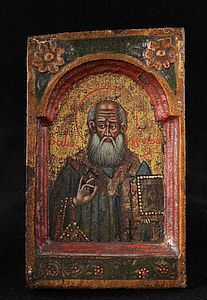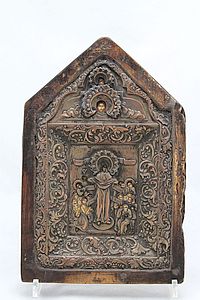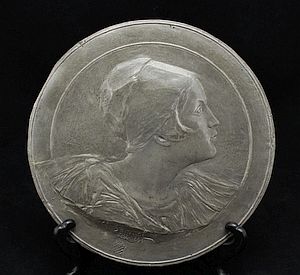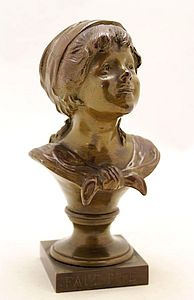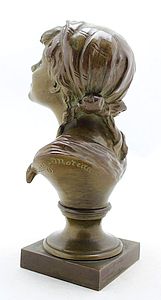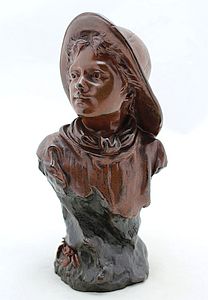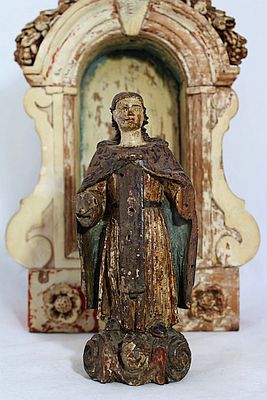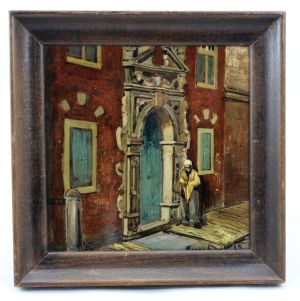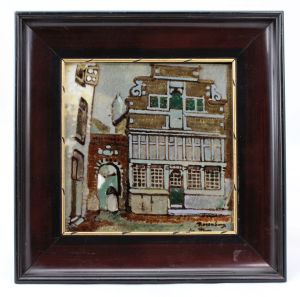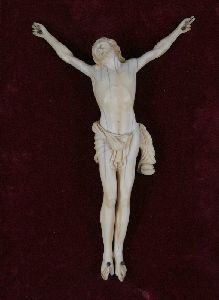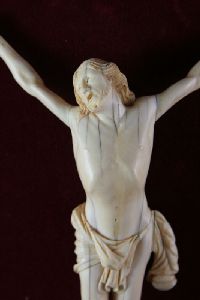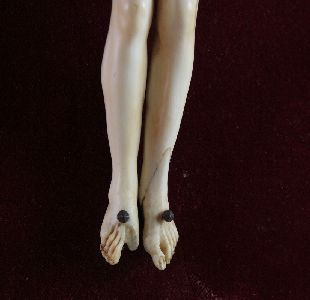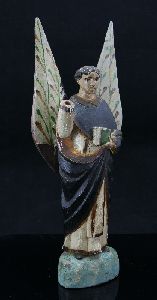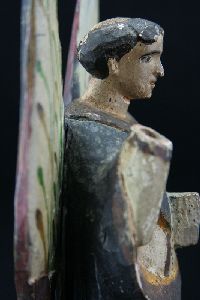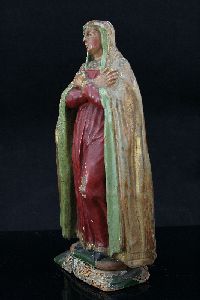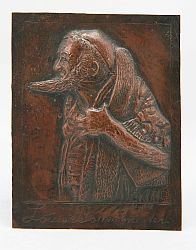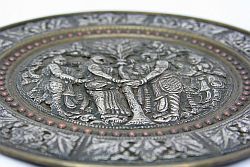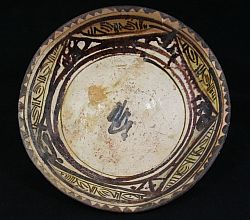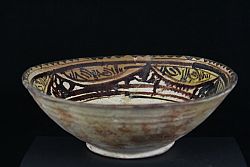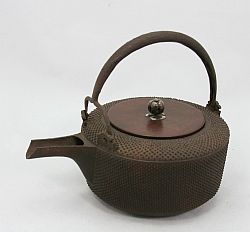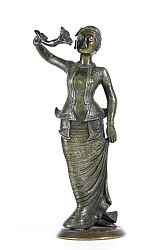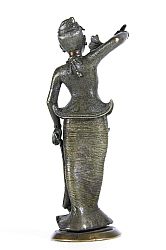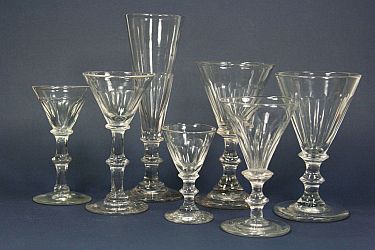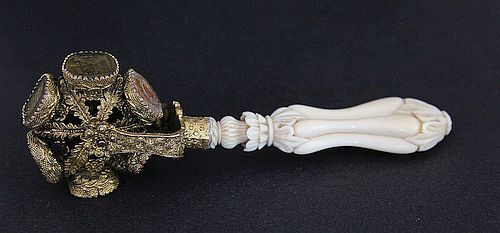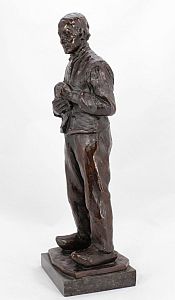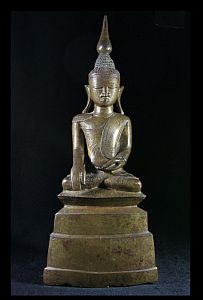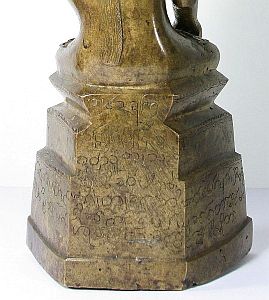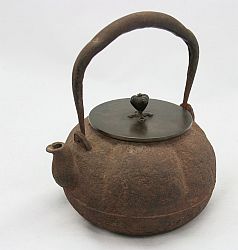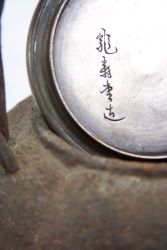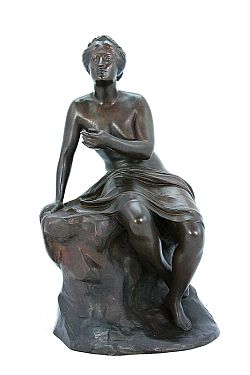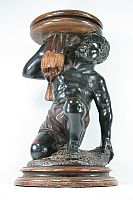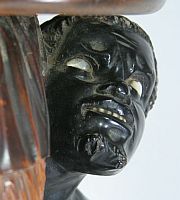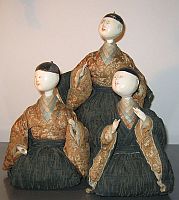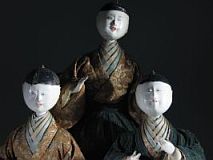antiques
|
a rare, carved wooden Nias statue, known as a Siraha Salawa representing a noble Nias ancestor figure or priestess, here as a dual gender / hermaphrodite sculpture with male and female ornaments, an armless figure is called Adu Horo this statue is made by the Peoples of Central Nias, an island of Indonesia length: circa 67 cm / 26.4 inc - price on request |
a collection of west African tribal art Maternity figures, for information and sales please see our eBay.com shop Delta 98 Den Haag
|
|
 |
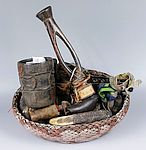 |
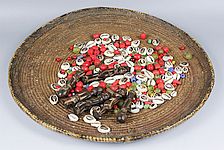 |
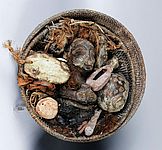 |
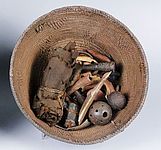 |
 |
a collection of west African divination baskets, all with diviners tools, soon available
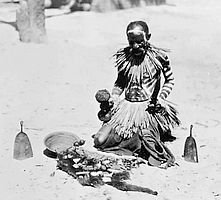
and here below, a part of our collection of African tribal art figures, masks, statues, oracle boxes and divination objects
also soon, or already available on eBay.com - in our shop: delta 98 den haag
|
an antique, early 19th Century doll with original clothes a wax over papier-mâché head and shoulders, with fixed head, the wax part is covered with craquelure and seems to have a few old repairs with a hair wig, with blue glass eyes, a stuffed, hand stiched cloth body, with pale pink leather, lower arms, with all fingers and thumbs, she has a straw bonnet with textile flowers and black feathers she wears a, probably original, dress of a kind of tulle or gaze, this is somewhat frail and has some splits in the fabric, then a wide under-knee length skirt, under that a second, less wide one, then her undergarment are open drawers of ankle length her feet are dressed, not with shoes or boots, but with silk coverings - the silk is in a bad state, we have more pictures for details length: circa 22.4 inch / 57 cm., price: €1500,- |
|
an antique, 16th Century, full round carved wooden statue of the Holy Child Jesus blessing Christ is here presented as a chubby child, emphasizing his dual nature. The total nudity of the child refers to his human nature, while the gesture of blessing with his right hand reflects his divine nature. In his left hand he probably would have hold a globe for he was the Salvator Mundi. This kind of statue could be dressed according to desires and celebrations. Both arms were removable to make the handling and dressing possible. There are also small holes on the top of the child's head to place headdresses or a halo. On later dolls, the hair was carved directly into the wood. With many restorations, we see: an ear, several fingers, his feet, his genitals and maybe repainted, we have more pictures for details length: circa 22 inch / 56 cm., price: €2200,- |
|
a mid 18th century wine glass, a so called Amicitiae or Friendship glass / goblet used for a ceremonial toast to amity, made between 1725 and 1760, the engraving is typical for the Nothern Netherlands with Dutch text: De Goede Vrindschap heigth 19,5 cm / 7.6 inch - weight circa 280 gr. |
|
a 17th or 18th century birdcage to hang on the wall, or standing and to carry outside the outside container at the left top is for when the bird is allowed outside the cage, although with a leash on his leg messures circa 27x24x15 cm / 10.6x9.4x5.9 inch |
|
a bronze sculpture, formed as a mask, depicting the face of a man with beard or goatee attributed to: Jeanne Elisa Henriette / Eliza Beetz Charpentier (Belgium, 1859-1928) it might be a portrait of het husband: Alexandre Charpentier (1856-1909) length circa 14 cm / 5.5 inch - compare a bronze mask by Eliza Beets of Jan Toorop - |
a very rare and authentic old, carved wooden figure of a woman with exceptional hairstyle, because of the fan-shaped coiffure it might not just be a
Luba statue, but a high ranked female ancestor figure of the Zande / Azande People
- Azandeh, Zandeh, Adio, A-Zandeh, Sandeh, Azende, Bazende, Niam niam, Nyam nyam, Neam nam, Neam neam -
living in the suthwest Sudan, Central African Republic and northwest Democratic Republic of Congo
or also possible: a lady from the Oromo in Jimma, now Ethiopia
- Oromia, Orimya, Oromyiaa, Jimmaa -
height: circa 21cm / 8.2 inch - price on request
a very rare African tribal art, wooden statue of a deformity figure with attentuated arms, made by the
Ibibio People of coastel southeastern Nigeria and related to the Efik and Annang Igbo
- see for a comparative statue the Anna Goerdt Collection - book: Deformity masks and their role in African cultures, page 45, plate 19 -
the statue here depicts a deformed female figure without arms, her hands are at her shoulders, with an elongated, swollen belly and a rope around her neck and waist
- documentation can be found saying: (...) in extreme cases of illness a heavy rope is tied around the patients body to hold her together (...) -
height excl. the base: circa 46 cm / 18 inch - price on request
for more tribal art from Africa, Indonesia and Oceania see more below and our Ebay.com shop: delta 98 den haag, for example:

2 Orientalist watercolors / gouaches om paper of an Arabian landscape in North Africa
framed with glass front - dimension incl. frame: 62,5 x 47 cm - excl. frame: 45,5 x 28,5 cm - no signatuur or date found - very nice condition
- sold -
|
a canoe protection figure Nguze Nguze with facial tattoos from the Solomon Island, Oceania price on request Nguzunguzu figures were fastened to the canoe prow at the waterline, so that it dipped in the sea as the vessel rode the ocean swells, it served as a supernatural guardian, protecting the crew during the hazardous voyage and ensuring the succes of the expedition, whether for fishing or head-hunting enemies |
a large, old and extremely rare, carved and stained wooden figure, the face heavily decorated with tattoo motifs,
these figures are known as Nguzunguzu or Toto isu or Musu musu, also written as: Nguzu nguzu, Totoisu and Musumusu
a canoe figure - prow ornament made by Peoples of a Central Solomon island, Melanesia, in the Pacific Ocean
We see a buste with head and arms, carved of light and soft light-weighted wood, darkened with ashes or charcoal, the head with a cap of wing-like / horn-like form, an open mouth with carved teeth, a small nose with a nose ring of beads of, as we believe, white coral or shell, arms bend and extended forward, the hands clasping a smaller head, like a dog's head, stretched ear lobes with a large open space / the helix cut and extended and a small hole in the middle, at the back the 2 holes / perforations for attaching it to the prow. The tattoos represent floral motifs and some animals, there are geometric forms, as chevrons and circles, the lozenge on the forehead symbolizes the tropical almond tree. The face reveals the original light color of the wood and is decorated with many carved details, rubbed in with chalk, depicting tattoos. Male tattooing was never this extensive and compare the more common Nguzunguzu with white shell inlaid faces (see our other Nguzunguze further below) and historical photographs, those white inlays represent the white paint warriors put on their face. Complicated tattooing seems to be applied to mainly women. Is this a female ancestor spirit? Considered to be a Talented Woman; a woman who excellend in several skills, because only few women were tattooed so extensively as this face is. The traditional religion recognized beneficient female spirits, like the ai ni asi or ai la matekwa, the Woman or Goddess of the sea, as some Solomonese have it, can bestow mana on people. And the same obtains with the Geo a female deity worshipped in the Maliata hills, in Guadalcanal, and generally in the central province of the Solomons. Furthermore, in connection with the power of women, it is significant that when possessed by a spirit, a woman may very effectively counter the decision of a chief and cancel all his plans. Or does it represent a male ancestor spirit? Because the enlarged earlobes for huge ear ornaments and the nose ring seem to be male jewellery. We would like to point out the possibility it being a representation of a Tindalo - the spirit of a dead man who, in his lifetime, possessed great mana or power. Please see the famous stone head of a Tindalo in the collection of the Australian Museum, acquired in 1911, registration number E019217. Further: on Guadalcanal the creator-being was Koevasi and was female. She was married and her husband Sivatohu was the great warrior of the sky. The fact that Kowvasi was the creator and Sivatohu the warrior, seemed to be the basis for the division of tasks between male and female on Guadalcanal. Only by analising the specific way of the facial tattooing / decoration the place of origin of this piece can be determined. This kind of tattoo seems to origine from Guadalcanal. Please compare a female figure from Guadalcanal in the collection of Musee de quai Branly, France, a spoon and a stone head from Guadalcanal in the collection of the British Museum. But concerning specific origin, we would like to quote Deborah Waite, University of Hawai'i: (…) Accurate island provenances are by no means always available for the objects in question. When a provenance is provided in museum documentation, it is often not clear whether the provenance refers to the place of collection, observation or production. Often the author of the provenance is unclear. The nature of collecting often results in an unbalanced collection; thus, certain islands are represented with frequency while others go unrecorded and unmentioned(…) The small head, held in the hands has dog-like features. Perhaps it represents the head of the mythological dog. According Waldemar Stohr in Kunst und Kultur aus der Sudsee, page 209: a dog has learned humans to fish. Other studies: a dog taught men all they know, f.e. learned humans how to built a canoe / boat. The more common Nguzunguzu show the dog's head incorporated in the features of the spirit's head, leading to the form with prognatic features, the large jaw. See Anthony JP Meyer in Oceanic Art, part II, page 388 and 398.
Age unknown, but how it is made, with primitive tools, the ash/charcoal coloring and the authentic signs of age, all convinces us it is made in the 19th or early 20th century.
Provenance unknown, but we would like to point out a very similar canoe prow ornament / figure in the collection of the Pitt Rivers Museum, Oxford, England, collected in 1939 by the anthropologist Alan Herbert Coltart (1885-1937) and they give notice of one in a private Sydney Australia museum of primitive art
Height including the stand: circa 56 cm / 22 inch - weight circa 2322 gr. Height excluding the stand: circa 44 cm / 17.3 inch - weight circa 1235 gr
price on request
some other words for searches: Mon war canoe prow figure de proue de pirogue, canoe, archipel isles inseln des Salomon, Galionsfigur, vom Bug eines Plankenboots, Kopfjagdboot, Mon-Boote, Zentral-Salomonen, farbgebung schwarz, tatauiermuster, voorstevenversiering, kanobeeld, centraal Solomon Salomon eilanden
|
an antique, carved wooden Nias statue, known as an Adu Nuwu sometimes refered to as, or confused with, an Adu Horo or Adu Zatua, representing an ancestor figure of a noble Nias warrior standing on a head, made by the Peoples of Central or South Nias, an island of Indonesia length circa 61cm / 24 inch price: € xxxx - sold |
|
an antique, very large, carved wooden Nias ancestor figure, a Siraha Salawa statue, length circa 123 cm / 48 inch price: € xxx - sold |
|
antique, 19th Century wax seal as a bust of the Greek goddess Athena, wearing a Corinthian helmet, the protective goatskin: the Aegis and on her chest a Gorgoneion - Medusa head, on the matrix the initials: M.A.K. length circa 9 cm / 3.5 inch price: € 590,-, EU shipping only
|
|
an antique wax seal price: € 290, - EU shipping only
|
|
antique, 19th century wax seal richly cut with a Chinese dragon, a bat and a butterfly intinials on the seal: J.M. K - sold -
|
|
this antique, 19th century, wax seal with the coat of arms / familiewapen of the family Quarles van Ufford, was made by Franz Jauner, Hofgraveur, Augustinergasse No.1157 Wien / Vienna and comes with it's original fitted box, the motto on the seal is a quote from Erasmus: Aquila non captat muscas & Qui invidet minor est, for: The eagle doesn't capture flies / don't sweat the small things & He who envies is lesser - length of the seal: 7,5 cm - EU shipping only - price on request this painting depicts the The Hague nobel family of Pieter Quarles van Ufford (1677-1744) and Cornelia Splinter van Loenersloot / Loedersloot (1677-1756), painted circa 1725 by Gerard Hoet (1645-1733), collection Haags Historisch Museum, The Hague |
|
a protection figure from a canoe prow from the Solomon Island, Oceania Nguzunguzu figures were fastened to the canoe prow at the waterline, so that it dipped in the sea as the vessel rode the ocean swells, it served as a supernatural guardian, protecting the crew during the hazardous voyage and ensuring the succes of the expedition, whether for fishing or head-hunting enemies price on request |
a part of the the Oceania collection of Delta 98 Den Haag, The Hague, The Netherlands
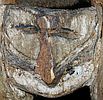




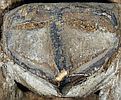
for sizes and prices please contact us
|
chest ornament of the Asmat People, Papua New Guinea - sold - |
a bark wood painting Australia - sold -
|
|
two parts of a Kle hili, a shield from the island Wetar - sold -
|
|
3 old african pieces of jewelry, to be worn by men, as pendant on the chest, known as Thungbubiel from the Lobi people, Burkina Faso, west Africa heights: carved 18 cm, bronze 15 and 16 cm condition: beautiful - authentic old patine, no restorations difficult to date, but pre 1960, and probably end 19th - first part of 20th century price on request other terms: brass cuivre ivoire messing brons ivoor ivoren object pendant amulet ornament pendentif talisman elephant pipe Birifor Ghana
|
9 ancient, stone and glass face / head beads
we believe they are:
1 phoenician glass pendant, made 400-200 BC, made of mainly black glass paste with additions of orange red blue and white glass, this pendant is damaged, height: circa 4 cm / circa 1.5 inch.
2 glass Buddha beads or pendants, perhaps a head bead of a Hindu rosary / Japa Mala, made circa 600-300 BC BC in India, made of yellow and red glass paste, one has just one face and a carved stone on top the other is a two faced / double faced Buddha bead and has a glass (?) top, both seem to be missing a curl, no cracks, no restoration, heights: circa 3,5 cm / 1.3 inch.
1 two faced stone bead made, circa 300 BC in India, made of a kind of turquoise stone, perhaps Amazonite, with on both sides a hand carved face, one side with mouth, the other side without mouth - no cracks, no restoration height: circa 2,6 cm / 1 inch,
5 two faced stone beads, made of a redish stone with blue/green, perhaps Jasper, made circa 300 BC India, all 5 ball shaped, with on both sides a hand carved face one has a slight crack, no restorations, heights: circa 3,1-3,4 cm / 1.2 inch
other terms of interest: Carthago, Syria, East Asian antiques, Indian antiques, prayer beads, guru bead, sumeru, bindu, moonface, moon bead, Indus Valley culture, Early History period, Himalayan discoid, spindl whorl, babagoria, baba ghori, ancient Tamil, hindu Deity, hindu god Agni, Janus head, Janus kop, kraal, kralen, perle
see on our Ebay.com shop: delta 98 den haag
|
18th C. wooden dance mask of Dharmapala / Mahakala, Tibet |
19th C. Indian miniature, depicting an audience of Sir Thomas Roe at the Great Mughal |
19th C. bronze of the Jagannath Trinity: Krishna, Subhadra and Balarama - sold - |
18th C. bronze of Shiva as King Warrior: Khandoba and Vahana |



Looking Left
a part of the Delta 98 Den Haag collection of African tribal art
for sizes and prices please contact us
|
carved wooden female figure, known as: Tugubele, made by the Senufo People - sold - |
carved wooden figure of a standing female, an altar or ancestor figure, we attribute it to the Niongom People - Dogon - Mali - sold - |
carved wooden figure of a standing female, style related to: Akan region, of reddish, light brown wood with black colouring, with accented eyes, nails and loincloth - sold - |
|
a rare and interesting doll of black latex or natural rubber, probably from Suriname, 18th Century clothing like this can be found on etchings/ drawings made in Suriname, by John Gabriel Stedman (1744-1797) and it is known that Stedman took some "wax" dolls, representing the Peoples of Suriname with him to Holland for Willem V of Oranje Nassau, see: Haags Historisch Museum - Afrikaanse bedienden aan het Haagse hof, page 15: Slavernij en opstand - sold - |
an 18th Century carved wooden statue, depicting an European male figure with a typical round and smooth face, with red cheeks from the heat and red lips, he is wearing 18th century clothing: a vest with buttons, over his shoulder a draped scarf and he is holding a chain, therefore we presume this figure represents a Slave Trader or Plantation Owner - slavenhandelaar -
|
a doll, made circa 1930, representing a Safari Girl, she resembles the famous American traveller and explorer: Osa Johnson Osa Johnson is also known as: The Woman in the Safari Outfit, Osa Helen Johnson Leighty (1894-1953) and Martin Elmer Johnson (1884-1937) were an American couple, adventurers and documentary filmmakers. They travelled and explored Africa in the 1920's and 1930's. - sold - |
|
2 old ceramic African vessels; ceremonial jars or divination bowls. The decoration is refering to the story of the Lion King Sunjata. These are not ordinary containers for food or water, but objects of ritual importance, they are made by a specially skilled potter for religious rituals, decorated in very high relief with human figures and animals. Made in West-Africa, usualy this ceramic is from the coastlands, or for example from the Baatonu / Bariba People from Benin, or Yorouba from Nigeria, but the visual story told by the figurativ decoration is from Mali, the old Empire of Sundiata Keita / Sunjata, the Lion King, in the 13th. Century and therefore we believe it to been made by the Mandinka People also known as: Malinke / Mandinko / Mandingo / Manding On one pot you can clearly see a male figure riding on the back of a tamed lion and two hunchback figures. The hunchback figures are the grandmother and mother of Sunjata, the mother's name is Sogolon, Sogolon Kedjou / Koudouma / Kondouto / Conde / Kolonkan. Sogolon was the daughter of Buffalo Woman, their family totem was the buffalo. The story on one vessel (the females pot) shows us how she was choosen above all beautuifull women of the land of Do of King Mansa Gnemo Diarra, who all had gold in their hair and their wrists bent under the weight of heavy silver bracelets, to become, as predicted, the second wife of the King of Mali, King Nare Maghan Konate Keita, with the lion as family totem. Sogolon gave birth to a son who was or became disabled, his name was Prince Jata Keita / Sogolon Jata / Sogolon Djata / Sunjata / Sundiata Keita. On the Lion King pot, you will find Sunjata riding a lion, his mother Sogolon, his grandmother Buffalo woman, his full sisters Sogolon Kolonkan and Sogolon Djamerou and his halfsister Nana Triban / Nana Faamaga. Nana is probably the girl with the ponytail, she holds a flask or container in her hand, she was the sister who was at the court of Sumanguru and gave Sunjata important information, wich abled him to reconquer his father's kingdom. More visible on the left vessel, the Lion King Pot are: 2 human figures with a hunchback, one holding a staff, the other holding a dog-like figure on the rope, a monkey-like figure, a female with sacrifications on her forehead and cheeks, holding a divinig/dowsing rod, a human riding a tamed lion, a snake head upwards, a turtle, a small female with elaborate ponytail. The right vessel, the Females Pot, shows a human with a hunchback holding a divinig/dowsing rod, a bird-like figure, a turtle, a beetle-like figure, a female with sacrifications on her cheeks holding a dog-like figure, she is held by her left arm by a female figure (head is missing) with a heavy necklace, breast of an old women, she wears a bracelet on her right arm, she is held by her left arm by the next figure, a female, again with sacrifications on the cheeks, with a delicate coiffure, a bracelet, she also holds the next figure, a female, again with sacrifications on the cheeks, who holds a stick or staff more info and price: see our eBay.com shop Delta 98 Den Haag |
Far Faces
a part of the Delta 98 Den Haag collection of tribal and applied art from Indonesia, Melanesia and Oceania
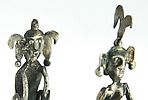
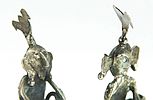
for sizes and prices please contact us or
see on Ebay.com - Ebay shop: delta 98 den haag
|
a life size, 3 dimensional carved, wooden male figure, representing a founding Ancestor or Guardian Figure, known as: Waken or Wan, we attribute this carving to the Sawos People, perhaps Yamok village, middle Sepik region, Papua New Guinea - sold - |
|
a rare, highly decorative and rich decorated pair of antique Indonesian rod puppets, so called Loro Blonyo as Wayang Golek a Javanese wedding couple, called "Loro Blonyo", which can be translated as "inseparable couple", this pair are the much more rare types of Loro Blonyo, because formed as Wayang Golek figures, the 3 dimensional Indonesian rod puppets - sold - |
a carved wooden Gope, spirit board, made by the Peoples of Papua New Guinea - sold - |
|
carved wooden figure, known as a Siraha Salawa, representing a nobel Nias Ancestor Figure - the non-nobel statues are called Adu Zatua - this statue is made by the Peoples of Nias, an island in the Samudera Indonesia - the Indian Ocean, west of Sumatra - sold - |
small bronze figure, a Siraha Salawa, representing a nobel Nias Ancestor Figure - sold - |
Siraha Salawa, Adu Horö and Adu Zatua - carved wooden ancestor or protective figures from the Nias People, Indonesia
from the collection Delta 98 Den Haag, The Hague, The Netherlands

![]()

for sizes and prices please contact us or
see on Ebay.com - Ebay shop: delta 98 den haag
|
a carved wooden statue of a hermaphroditic - dual seks and forked figure, known as a Adu Horö, a Nias protective / ancestor figure - function: remission of sins representing Silewi Nazarata, the primordial Nias priestess, a main South Nias mediator / intermediary / intercessor with the gods - sold -
|
carved wooden statue of an androgynous forked figure, known as a Adu Horö, a Nias protective figure Adu Horö figures were fastened to a central pole in the house of a Nias chief / nobleman or put leaning against the osa'osa or gari, they were intended to ameliorate the spritual consequences of war and head hunting, they serve a protective function for the house this statue is made by the Peoples of Nias, an island in the Samudera Indonesia - the Indian Ocean, west of Sumatra |
|
|
|
|
|
a pair of early 18th century, double walled, glass beakers so called: Zwischengoldbecher probably ment as Kiddush cups for the Shabbat dinner, made circa 1750 in Bohemia clear colourless glass with gold leaf, flat base, conical body, vertical cut facets, cemented seam around the upper rim, finished with gold - one of the 2 techniques for making the Zwischengoldbecher / Doppelwandgläser - the inner gold decor depicts 2 four-winged angel/ cherub like figures, with curly beards, wearing long robes with a decorated border and they are wearing sandles, on their head is an impressive crown, of which the form seems to go back to Babylonian times when the Jewish exile took place, because of the similarity with the crown of the hieroglyph of Mandulis in the temple of Kalabsha - the figures wear an Elamite dress, an Egyptian crown, and 4 Assyrian wings; all member countries of the Persian empire - the crown is known as the Mandulis crown, but also as the Hemhem or Triple Atef crown and is of Egyptian origin - the crossed wings are of Assyrian origin - the robe is an Elamite garment - this angel/cherub figure is an almost exact copy of the Cherub / Good Genius of Pasargadae in Iran/Persia the total image can be found as a relief at the entrance hall / Gate R of the palace/paradise in Pasargadae of Cyrus The Great - the Bohemian glassmaker confused the upright cobra's on the sides of the crown with antlers, or did he do this on purpose? - the cherub is a guardian and one is reminded of the cherubs who guarded the Garden of Eden. The above mentioned and much more information is given me by Prof.Dr. Jacobus van Dijk, University of Groningen, he has been a wonderfull and nice help and I am very greatfull, he also mentioned that with this information, the dating of the glasses can be a problem. Although western travellers have visited the place in the 17th century, there seem to be no recorded images by western travellers of before 1808 heights: 11,2 and 11,5 cm, price on request |
|
a collection of 5 antique wax seals, all related to the family Baud, The Hague, and especialy to Elisabeth Wilhelmina Johanna Baud, initials EB, because of her marriage and collaboration with Louis Couperus and their shared love for Middle Eastern history, resulting in the novel Iskander, published in 1920, with as main characters Alexander The Great, versus Darius III, also known as Dareius / Darique / Artashata / Darius Codomammus, selling as 1 lot - price on request the 3 seals with initials, A - E.B - J.C.B. - showing the family Baud motto: Otia Dant Vitia, surrounded by a closed belt and topped with a nobel crown |
|
sold |
|
antique small, cire perdue bronze Indian or Indo Javanese statues of Hindu Deities, 10th - 13th Century selling on Ebay.com - Ebay shop: delta 98 den haag - shop category: Asian antiques
|
|
Nilavilakku standing oil lamp - sold |
antique Indian hand held oil lamp with Peacock / bird - sold |
Thookku vilakku large hanging oil lamp - sold |
|
18th and 19th century antique Hindu Indian oil or ghee lamps - antieke olie / vet lampen, some from Kerala selling on Ebay.com - Ebay shop: delta 98 den haag - shop category: Asian antiques or Lamps
|
|
a stained-glass, leaded enameled window with a female figure depicting St. Catherina, standing at a spiked wheel Saint Catherine of Alexandria also known as Saint Catherine of the Wheel and The Great Martyr Saint Catherine Catherine was condemned to death on a spiked breaking wheel, but at her touch the wheel shattered made by Jan Schouten, Johannes Lourens Schouten - Dutch, 1852-1937 from the Prinsenhof atelier / Atelier voor gebrandschilderd glas 't Prinsenhof in Delft Holland / The Netherlands signed with monogram JS and Delft at the bottom left. because it seems to have been a part of a piece of furniture, it might be from the estate of Lambert van Meerten (1842-1902) of Huis Oud Holland, Oude Delft. His furniture was sold after his bankruptcy in 1902 measurements: 81 x 31 cm. (excl. frame) price: € xxx - sold -
|
|
two terracotta and a polychromed plaster reliefs of 4 Apostles and St. Lucie
voorstudies voor de Vier Apostelen, circa 1925 uiteindelijke, andere uitvoering in kerk Maria Onbevlekt Ontvangen Besoyen, Waalwijk en St. Lucie, gedateerd 1943 Termote's moeder heette Lucia en zijn vrouw Lucie / Lucia Maria Leonard (1889-1979)
by: A. Termote, Albert Polydor Termote (1887-1978) with clear monogram: AT, lengths: 29 & 22,5 cm., some damages prices: € 440,- and € xxx
|
St. Lucie by: Albert Termote sold |
|
wooden carving, depicting a lioness by: A. Termote, Albert Polydor Termote (Netherlands, 1887-1978) with clear monogram: AT and date LXV length: 32 cm, height: 19 cm. several natural woodcracks, no missing parts, no restoration, firm
|
antique russian and greek orthodox icons
selling on Ebay.com - Ebay shop: delta 98 den haag - shop category: religious
|
- sold - |
- sold - |
|
an antique pewter plaque, depicting: Nele the friend of Tijl Uilenspiegel / Till Eulenspiegel / Dyl Ulenspegel made by: Charles Samuel (Brussels 1862-1938), dated: July 1895 and marked: la feuille d'etain enfants pauvres Bruxelles probably sold and ment as fundraising to able the philanthropical organisation La Feuille d'Etain to buy shoes and clothes for the poor children of Brussels diameter: 23 cm / 9 inch, price on request |
|
an antique, bronze sculpture, depicting the buste of a charming young girl, titled: Fadette Fadette is a character from the, in 1849 published, novel La Petite Fadette or Fanchon, the Cricket, by George Sand / Amantine Lucile Aurore Dupin (1804-1876) designed by: August Moreau (France, 1834-1917) executed circa 1885, with clear signature: Aug - Moreau height: 19 cm / ca. 7.4 inch - weight: 1510 gr. condition: beautiful - authentic old patine, no restorations, 1 screw under the base seems to be replaced - sold - |
|
a rare, antique, bronze sculpture, depicting the buste of a Fisherboy - a young boy wearing a sou'wester, with a crab designed circa 1900 by: Antoine Bofill (Spain & France, 1875-1921 or 1939) signature: Bofill, numbered /2, and with a founders mark (unknown to us) executed circa 1900, original patina in two colors height: 19,5 cm / ca. 7.6 inch - weight: 1520 gr. condition: beautiful - nino pescador, garcon de peche, jeune pecheur, french marine boy, jonge visser, zuidwester, chapeau des marins, suroit, southwester - for sale through our Ebay.com shop: delta 98 den haag |
|
an authentic old, 17th century, carved wooden antique Altarpiece - Retable with Saint the full round carved wooden male figure depicts Saint Anthony of Egypt - Anthony the Great Dutch: retabel met de Heilige Antonius Abt / Sint Antonius van Egypte the figure is wearing a scapular and a hoodless mantle held in front by a clasp, his hermit robe / garment is hold with a belt, he wears shoes, he has nicely carved long hair, his hands are missing, in his right hand he would have had a Tau cross and in his left an open book, he is standing on an all round carved cloud with in the centre a putto's head with wings the shrine / cabinet has forged iron nails and blackening through candle smoke, the front has floral carving, hardly any polychrome left the combination of figurine and shrine could be a marriage condition: firm, stable and good for it's age, the figure with a warm authentic patine, arms are missing, authentic old damages to the paint and wood, old - now harmless, worm holes messurements circa 45,5x26x10cm, price on request Saint Anthony or Antony lived circa 251-356, he was a Christian monk from Egypt, revered since his death as a saint. He is distinguished from other saints named Anthony by various epithets: Anthony the Great, Anthony of Egypt, Anthony the Abbot, Anthony of the Desert, Anthony the Anchorite, and Anthony of Thebes. For his importance among the Desert fathers and to all later monasticism, he is also known as the Father of All Monks. His feast day is celebrated on January 17 among the Orthodox and Catholic churches and on Tobi 22 in the Egyptian calendar used by the Coptic Church |
|
a decorated and glazed ceramic earthenware tile, so called plateel, marked for 1902, and: Rozenburg, Den Haag - Royal Manufactory of Porcelain and Pottery, The Hague, Holland depicting - Oude Vrouwenhuis, Haarlem -, the old ladies home in Haarlem, Holland messures: 15,5 x 15,5 cm (the tile), price: € 325,- |
|
a decorated and glazed ceramic earthenware tile, so called plateel, executed circa 1900-1905, by: Rozenburg, Den Haag - Royal Manufactory of Porcelain and Pottery, The Hague, Holland depicting a painting after Johannes Vermeer (1632-1675), known as - Het Straatje - or - Gezicht op huizen in Delft - messures: 15,7 x 15,7 cm (the tile), price: € 460,- |
African tribal art: authentic old, carved wooden statues
selling on Ebay.com - Ebay shop: delta 98 den haag - shop category: African etnografic
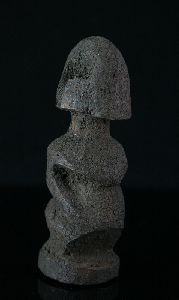 | 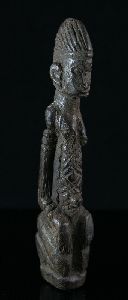 |  |
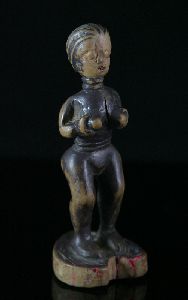 sold sold |
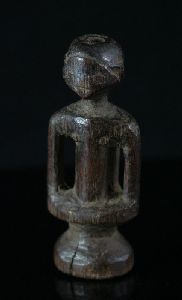 sold sold |
antique bronze Indian statues of Hindu Deities - authentic 16th 17th 18th 19th Century
selling on Ebay.com - Ebay shop: delta 98 den haag - shop category: Asian antiques
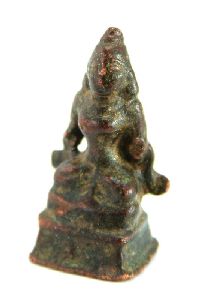 sold sold |
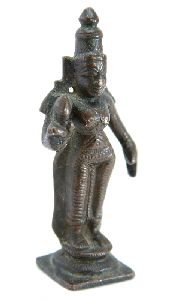 sold sold | 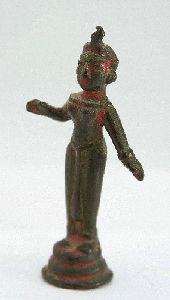 | 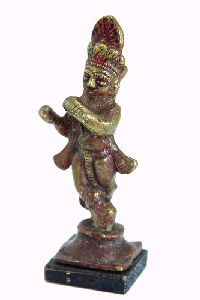 |  |
an antique, carved Corpus Cristi
made circa 1780-1800, length of the Corpus: circa 23 cm / circa 9.1 inch
with well kept bright patina, some missing parts: the big toe of his right foot, the upper part of his right middle- and fore finger, a part of his left pink and ring finger
price: € 650,-
|
a large antique glass vessel, with enameled painting, known as: Reichsadlerhumpen or: Imperial Eagle Beaker, Eagle Glass, Adlerglas cylindrical shaped, clear, slightly cloudy, free blown glass decorated with a double-headed eagle, the Quaternion Eagle of the Holy Roman Empire, with on it's wings 56 coats of arms text above the eagle: Das heilige Romische Reich mit sampt seinen Gliedern und Allem zugleich on the back an enamelled date: 1624 height: 27 cm - diameter at the top: 14 cm weight: circa 1136 gr. condition: excellent, no chips, no cracks, no restoration, no deposit/scale selling on Ebay.com - shop: delta 98 den haag - category: antiques |
|
an authentic antique, carved wooden statue, made circa 1850 in southern of Europe, depicting: Saint Vincent Ferrer and called: the Angel of the last judgement feast: April 5 - attributes: wings and bible he has a Francisan friar's or clerical tonsure, and he might be missing his tongue of flame, polychrome painted, some paint missing, the back side has no detailed carving condition: the wood is firm and solid, no worm holes, one wing seems to be a replacement, his right hand is missing - perhaps he held an attribute there height: 31 cm / circa 12.2 inch selling on Ebay.com - shop: delta 98 den haag |
|
an authentic antique, carved wooden statue of Saint Anna made circa 1850, probably in Portugal polychrome painted - green, red and gold, back side has no detailed carving and no coloring, some paint missing on top of her head, her left knee and from the bases condition: wood of the upper part is firm and solid, a few old worm holes at the back, many old worm holes at the base, the base has been (re)placed at some moment - glue visible, on the back a piece of her cloak at de bottom is missing in spite of the damages this statue has a warm and very pleasant charisma, because of her detailed carved face with modest expression and the remaining gold on her clothing height: 25 cm / circa 9.8 inch now selling on Ebay.com - shop: delta 98 den haag |
|
a rare copper plaque depicting Louis Bouwmeester (1842-1925), a famous dutch actor at the age of 81 in 1923 as Shylock in the play The Merchant of Venice, written circa 1597 by William Shakespeare ... hath not a Jew eyes ... made by: Toon Dupuis (dutch sculptor 1877-1937) this plaque differs from the common, more seen, smaller one; here the left arm is visible and the lettering is totaly different 14,5 x 11,4 cm - price: € 290,-
|
|
an authentic early 19th century or even older plate, probably a Hindu offering tray or marriage plate the rich decorated plate is made with silver repoussé on a copper-bronze alloy, made in India, depicting a couple, perhaps Radha and Krishna standing by a single tree, with next to each of them a standing attendant, and above them two winged, celestial attendants - angels/cherubs/garuda's base repoussé is a technique where the material (silver) was hammered from the reverse side, the panels along the border and the central medallion are hand repousse silver, which has been applied to the bonze/copper plate surface condition: authentic signs of age and wear, some small pieces of the soft silver went missing in time, the plate itself is firm and in good order with authentic, warm patine, although some silver is missing the overall impression is of a tender, warm glowing feel diameter: 23,2 cm, price: € 240,- |
|
an antique ceramic bowl, with the interior painted under glaze with brown and yellow, the exterior has traces of glaze and yellow paint, we believe it to be a 11-13th century, Near East pottery bowl Syria or Persia height: 6 cm / ca. 3.4 inch - width: 16 cm / ca. 6.3 inch condition: firm, but with substantial restoration and a partial replacement of 1/5 of the upper part - in the decorated band - visible because of the used paint and not glazed price: € 320,- |
|
an authentic 19th century Japanese sake kettle - rice wine pot, with signed bronze lid CHOSHI a cast iron pot, with the specific sake-kettle spout, the bronze lid - futa, bears the family sign on the inside and has a beautifull redish patine, the lid can be even older, while the kettle/pot can be more recent, because the pots get damaged or broken, the lid survives and is passed on down in the family, the charming copper and silver lidknop - tsumami, can rotate total height: 20cm, fitting diameter of the lid: 9.7 cm condition: authentic signs of age and wear, with authentic unpolished patine, no holes, no cracks, no missing parts price: € 380,- |
|
an exquisite, antique bronze figure, depicting an elegant Lady from Burma made circa 1880-1900 she holds an open lotus in her right hand, with her left hand she holds up her sarong just a little to free her bare feet she is dressed in delicate decorated, expensive traditonal Burmese costume; the extremely elegant cut kebaya / blouse has small flowers and detailed borders and has it's typical triangular shaped endings, the Hta-main / skirt / longyi has stripes and zigzag patterns her hair is done in a traditional topnot coiffure, casted very delicate in the bronze, she wears a double necklace, held together on her back with a bow and she wears earrings condition: beautifull, authentic patina, no missing parts, authentic signs of age height: 18 cm, weight: 885 gr., price: € xxx - sold - |
|
an we have n extensive collection of antique glasses, in different shapes and sizes made between 1720 and 1890 please see our shop on Ebay.com - delta 98 den haag- for more antique glasses.
|
 |
some sold items:
 |
a very rare and exceptional antique Dutch spirits glass, circa 1720 with the folded foot shaped as a 18th century three-cornered hat heights: 11 cm, 11,5 cm and 13 cm., price each: € xxx 3x sold |
|
|
an antique, gilt metal and carved wax seal, made in the 19th century, probably in France, with a rotating wheel containing 6 matrices of engraved glass, refered to as: a Seal Wheel with intaglios, under the glass there seems to be gold foil, 5 intaglios have a motto or text, with a tiny image, 1 has only a laurel wreath: 1. Adieu Au Revoir - goodbye, with a sunburst above a mountain or pyramide 2. Toujours Attache - always attached, with a old tree and a young vine around it 3. Telle Est La Vie - such is life, with a three-master ship 4. Je Ne Change Q'En Mourant - I do not change except in death / I will remain steadfast, with a leaf 5. Une Lettre Adoucit Les Peines De L'Absence - a letter softens the sentences of abence 6. a laurel wreath price: € XXXX - sold - |
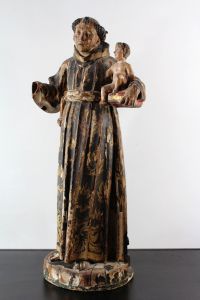 |
antique, in full round carved, 18th century wooden statue, depicting: Saint Anthony of Padua and The Holy Child Jesus made circa 1780-1800, in the Low Countries The carving is superb, especially St.Anthony's left little finger gives away it's detailed, skilful and artistic carving. St. Antony is standing with on his left arm the Holy Jesus. Jesus is seated on the Holy Bible. St.Anthony wears an elegantly draped monk's habit and sandles, the habit is decorated with gold ornamentation. The carved wooden statue Jesus is a loose part; it sits on a pin height: 72 cm / circa 28.3 inch price: € XXXX - sold -
|
 |
an authentic antique, in full round carved wooden statue, depicting The Virgin Mary and Child made circa 1800 in South Germany, of fruitwood, with remains of polychrome Mary is standing with the Holy Jesus on her right arm, she wears an elegantly draped tunic and mantle, she has long curly hair, and sandles (visible on her right foot) height: 54 cm / circa 21.3 inch, price: € XXXX - sold |
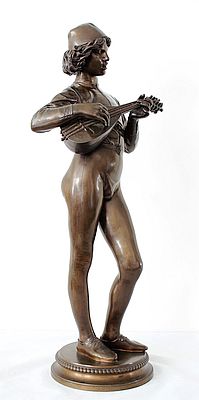 |
an antique, large bronze sculpture, designed pre 1865 by: Paul Dubois (France, 1829-1905) titled: Chanteur Florentin du XVe siecle - Fifteenth Century Florentine Singer depicting a beautiful young male, playing a Renaissance lute signed in the base with: P. Dubois 1865 - F. Barbedienne Fondeur - A. Collas, Brevete, reduction Mecanique executed circa 1865-1900, height: 76 cm / ca. 30 inch details: the young man wears a cap on his long curly hair, his mouth is open, teeth visible, on his slender silhouette her wears tight fitted clothing, a belt with a Satyr 's head as clasp, detailed shoe laces and cuff buttons, the wrinkles in his clothes caused by the boy's elegant pose give away the superb design and casting, the lute has a floral decorated board, ribbed body, an angled neck, 8 strings and tuning pegs (1 is a little crooked) price: € XXXX - sold
|
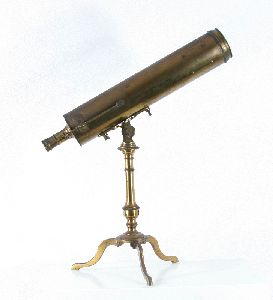 |
an antique 18th century brass Reflecting Telescope on a brass folding tripod stand, made circa 1770, inscribed on the circular backplate: L. van der Bildt Franeker - No.143 the makers first name is found as: Lubbertus or Lubbartus or Lubartus. Lubbertus van der Bildt lived and worked in Franeker, The Netherlands. He started numbering his telescopes in circa 1768, he died circa 1780. This telescope is numbered: No.143. Uuntil now serial numbers of Lubbertus were known, ranging from No.83 in the Louwman Collection, Wassenaar, The Netherlands, to No.139 in the Eisinga Planetarium in Franeker price: € xxxx - sold
|
 |
an authentic early 19th or 18th century Hindu Altar / Auspicious lamp so called: Nilavilakku - standing oil lamp the origin of this type of casted lamps lays in Kerala, South India, it is made of hand casted bronze - casted in 2 parts, you can turn the top off, so you can choose from 2 heights; a hand held or table/altar stand, it has it's authentic and unpolished patine heights: ca. 30cm and 14,5cm, oil holder diameter: 11,5 cm, price: € XXX - sold (code: LA) |
|
|
an extremely well sculptured bronze with beautiful patine, of a man crumpling his cap in sorrow made by: Eduard / Ed Jacobs (Amsterdam 1859 - 1931 Laren) founders mark: J.K.C. Sneltjes, Haarlem signed and dated 1914, height: 42 cm / 16.5 inch price: € XXXX - sold |
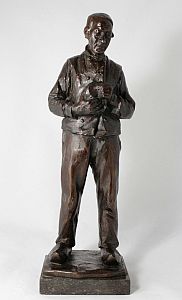 |
|
|
antique, carved wooden statue of the Holy Child Jesus standing on a celestial globe and pedestal made pre 1800, in the south of Europe glass eyes, polychrome painting, blue and gold - the upper part, especially the face has been repainted at one moment in time, at a few places paint missing (arms and back) condition: wood is firm and solid, a few old worm holes, item in left hand is missing height: 44 cm / circa 17.3 inch, price: € xxx - sold |
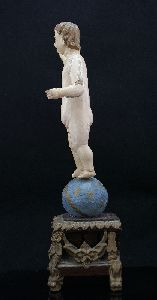 |
|
|
an exquisite antique, 18th Century, Burmese bronze Buddha provenance: a private estate / collection in The Hague, The Netherlands - 1960/1970 this Buddha is sitting in Vajrasana - with ankles crossed, with his hands in Bhumisparsa - with his right hand on his knee and the left on his lap, representing the Buddha calling the earth to witness with a delicate expression on his face through the fine modelling and engraving the statue is decorated with fine details on his clothing, ears, hands, foot and base there is engraved ancient Burmese text on the sides and back of the base height: 33,5 cm, width at the base: 13,7 cm condition: great, very good, with an authentic, beautifull warm and smooth patine, no restorations, no missing parts weight: circa 2,8 kg , price: € XXXX - sold |
|
|
a Saint or Friar with rosary made pre 1850, in the south of Europe an extremely attractive male, with a beautifull expression - his beautiful face, gesture, pose, golden curly hair, elegant clothing and shoes make it a stunning whole polychrome painting - gold, brown and black, a lot of paint is missing - but this gives it a highly decorative aura, the wood is firm and solid, no worm holes, item in left hand is missing height: 46 cm / circa 18.1 inch - price: € xxx - sold |
 |
|
|
an authentic 19th century Japanese waterkettle with signed bronze lid TETSUBIN a heavy and thick, cast iron pot, in the shape of a squash, the bronze lid - futa, bears the family sign on the inside, the lid can be even older, while the kettle/pot can be more recent, because the pots get damaged or broken, the lid survives and is passed on down in the family, the charming copper lidknop - tsumami, is ingenious attached and can rotate total height: 21cm, fitting diameter of the lid: 8.4 cm condition: authentic signs of age and wear, with authentic unpolished patine, no holes, no cracks, no missing parts price: € XXX - sold |
|
|
an authentic 18th century or early 19th century Hindu offering bowl and dish made of a zinc-copper alloy with silver inlay decor, called: Birdi ware the origins of Birdiware lay in Bidar, Karnataka, India the zinc surface is engraved with floral decorations into which the silver is beaten, the base metal then is blackened with a paste of mineral salts and the silver polished to create a contrasting finish condition: authentic signs of age and wear, some small pieces of the silver inlay went missing in time, the plate and bowl are firm and further in good order with authentic, unpolished patine diameter plate: 18,1 cm, diameter bowl: 13 cm - height: 5,6 cm price: € XXX - sold |
 |
|
Fré Jeltsema
|
a bronze statue, depicting an elegant seated female nude executed in 1920, designed by a famous dutch sculptor: Fré Jeltsema (1879-1971) born as female Frederika Engelina Jeltsema, later officialy acknowledged as male and his name became Fredrik Engel Jeltsema height: 33 cm / ca.13 inch signed and dated, excellent condition, authentic patine price: € xxx sold - now in the collection of the Groninger Museum, The Netherlands |
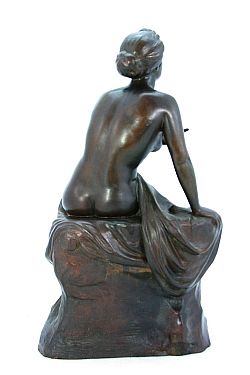 |
|
|
an impressive antique, 18th century oak wooden panel, depicting The Adoration of The Magi here as: three Kings from the East, offering gifts to the Holy Child, who is held by his mother, The Holy Mary and Joseph is standing next to her, and the Kings: Melchior, Caspar and Balthasar bringing gold, frankincense and myrrh probably Flemish of origin - Flandre, dated on the back: 1726, with it's original framing size: 88 x 76 x 10 cm / 34.6 x 29.9 x 3.9 inch, weight: 14,2 kg condition: very good, beautifull and firm, with authentic warm and smooth patine price: € xxxx sold |
 |
|
an impressive, authentic antique, 18th Century, fully carved, ebonised walnut plinth supported by a kneeling male, known as Blackamoor with a second circular top that revolves and raises, finished with a radiating geometric pattern his face has specific 18th century features; the splitted beard, the small white teeth and the eyes accented with shells giving him an unsympathetic look, he has beautifull detailed carved toes, fingers and cloth on a circular base - diameter: 33 cm height: 56 cm - fully extended: circa 80 cm condition: authentic signs of age, authentic patine, no missing parts, some old wormholes, but now clean weight: circa 8 kg., price: € XXXX sold |
|
3 antique Japanese dolls from the Mid Edo period, circa 1750-1780 so called: Hina Dolls or Hina Ningyo price: € xxx sold |
|
Tichelaar Makkum 1943, Al ware de doot op de lippen ..., J. Pzn. Coen 1623 |
Tichelaar Makkum 1943, De geest moet boven moeyelickheden sweven ...., J. Pzn. Coen 1623
|
|
2 rare and large Dutch faience, Delft ware wall chargers, mementoes of the Dutch Resistance during World War II made in 1943 by Tichelaar Makkum text on the plates: Al ware de doot op de lippen, daeromme moet men geen couragie verliesen. J.Pz. Coen, 14 Mei 1623 translation: Even in the face of Death, one should not loose courage / keep up a stout heart De geest moet boven alle moeyelijckheden sweven ende geensints daer onder buygen. J.Pz.Coen, 14 Mei 1623 translation: Let the mind float above all difficulties and do not let it bow to them. These mottos of Jan Pieterszoon Coen (1587-1629) were used as encouragement during WWII. Koningin Wilhelmina, the Dutch queen at that moment, concluded her speech at the beginning of World War II, to the Dutch population on May 14, 1940 with Coen's words: Dispereert niet / Do not dispair. These plates, made by Tichelaar in 1943, can be seen as, if not ment to be, a silent form of resistance during the war. We do not know why and how Tichelaar made these plates. But we think because it were words from the 17th century, the occupier probably did not realize the meaning at that moment and Tichelaar was able to produce them. In 1943, the Germans announced that 300,000 Dutch army soldiers, who had been captured and released in 1940, were to be recaptured and sent to German labor camps. As soon as this was announced, workers all over Holland, walked off their jobs in a protest strike. Rural Dutch farmers supported the strike by refusing to deliver milk to dairy factories. To combat these strikes, Nazi troops began shooting at the strikers throughout the country, and those strikers who were arrested were sentenced to death. 1943 is also the year that many Dutch students and teachers refused to sign the Loyaliteits Verklaring / Declaration of Loyalty to the Nazi occupiers. Those who refused to sign, had to go into hiding or were put to work in German labor camps. Many were executed or murdered in Holland or in Nazi concentration camps. One of them, the student Otto Cornelius Tichelaar, born in 1918, was murdered in Neuengamme, Germany in February 1945. After the war Queen Wilhelmina came back to Holland and in her favorite palace, Paleis Het Loo in Apeldoorn, she placed a table in the Grote Zaal of Audiëntiezaal / Great Hall or Audience Chamber, on which she placed mementoes, also two of these Makkum plates, as a tribute to the Dutch Resistance Movement. This table is called Verzetstafel / Table of Resistance. The plates and other items are still on that table today. Royal Tichelaar Makkum / Koninklijke Tichelaar Makkum was established circa 1660 in Makkum, a village situated on the banks of the IJsselmeer / Lake IJssel, a lake since 1932, but earlier an inland sea: the Zuiderzee / Southern Sea, in the northern Dutch province Friesland of The Netherlands. Centuries of ceramic history started out in with a brickyard halfway through the 16th century. Bricks were replaced for pottery in 1670, which changed into ornamental earthenware in 1890. The 19th century saw craft techniques disappear from the industrial production process. Koninklijke Tichelaar Makkum is one of the world's few remaining factories that continued to invest in traditional craft production processes. The relevant map in Caspar Robles' 1572 atlas shows a briccaria or brick factory on the site where the Koninklijke Tichelaar Makkum factory is now. This provides the earliest proof of a long company history. In 1640 the company became a family firm and remains so until today. The company has down the centuries displayed an exceptional awareness of its valuable tradition and now, in the twelfth generation under the leadership of Jan Tichelaar, it once again works to refresh and expand the development of traditional craftsmanship and ceramic knowledge, the company's core values. Economic and technological changes have never alienated Tichelaar from its traditional origins. The clay, a large proportion of which is still excavated locally, and the glazes, are still the two most important raw materials the company uses. The company's expertise also includes many of the production methods, such as hand-painting and the age-old and superior seventeenth-century faience technique - also called Delft earthenware. Jan Pieterszoon Coen, 8 January 1587 - 21 September 1629, was the founder of Batavia, an officer of the VOC - the Dutch East India Company in Indonesia, and holding two terms as Governor-General of the Dutch East Indies excellent condition, diameter: 34 cm, price: € XXX - sold - now in an Indonesian collection |


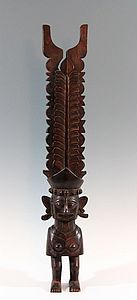
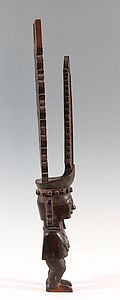
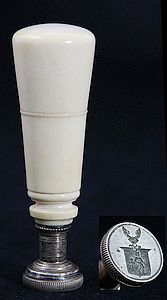












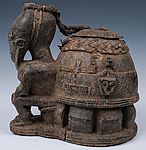

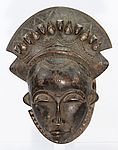






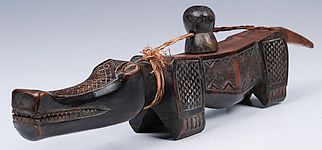
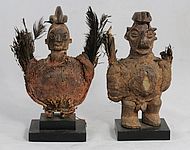



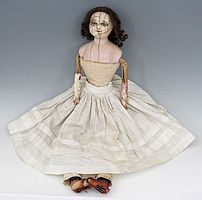
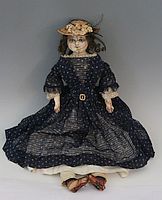
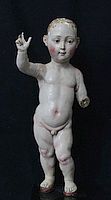



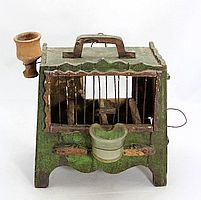

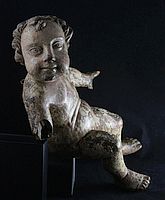
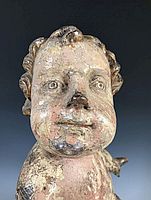
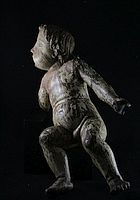

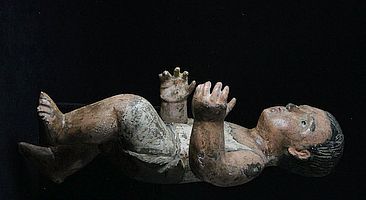
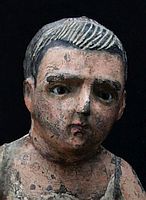




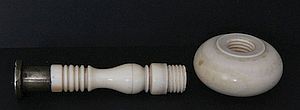
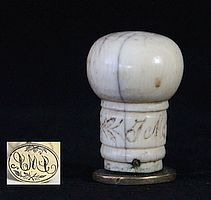
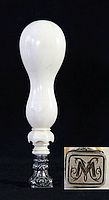
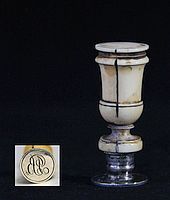


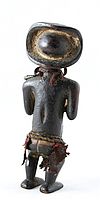
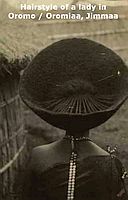
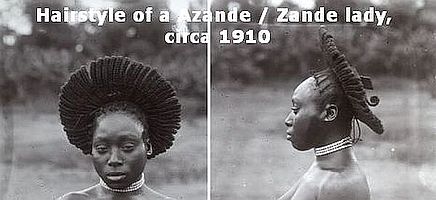

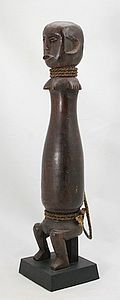
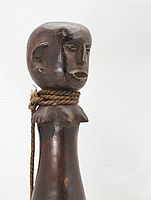




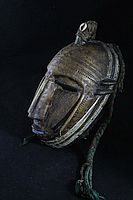

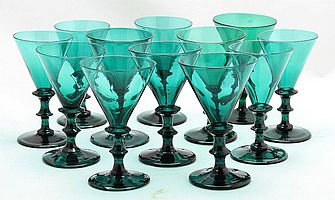
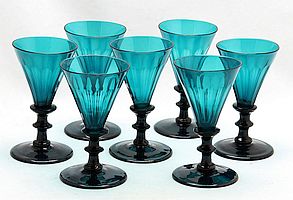
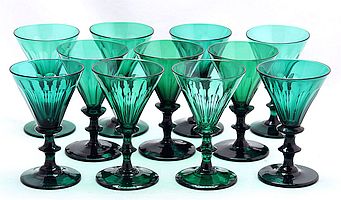

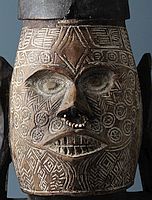
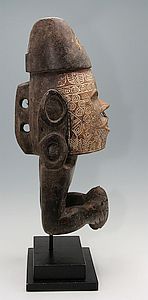


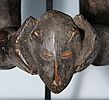
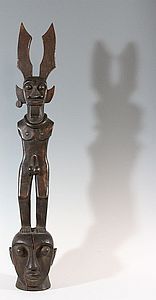
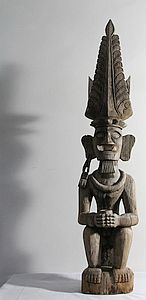
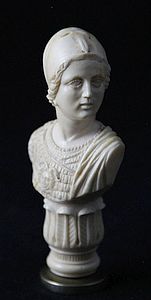
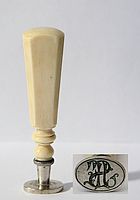
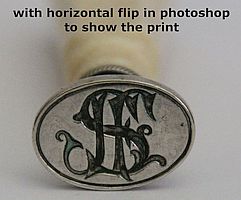

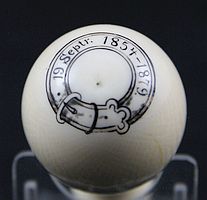
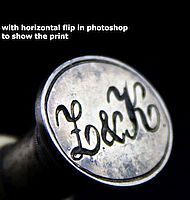

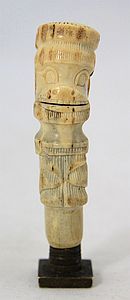
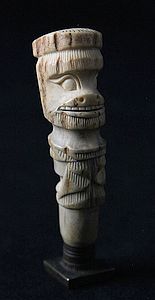
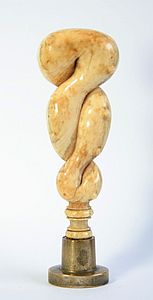
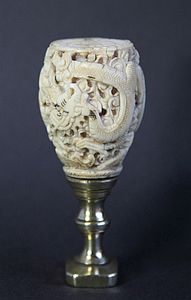
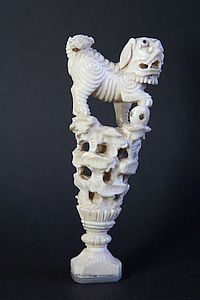
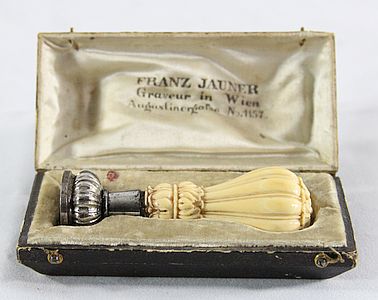
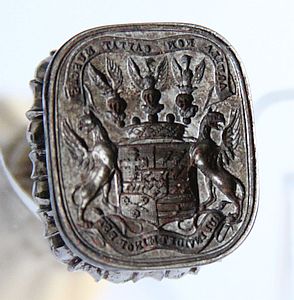
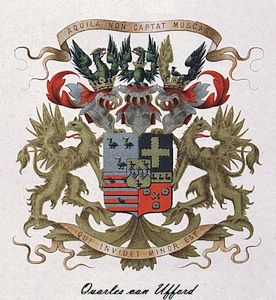
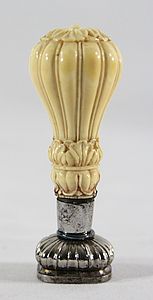

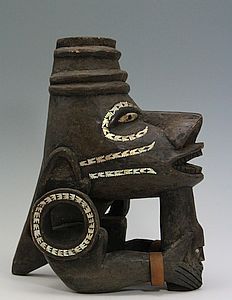

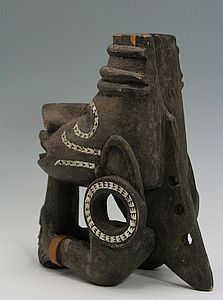

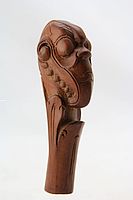




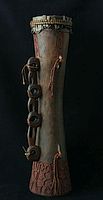
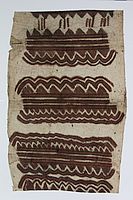








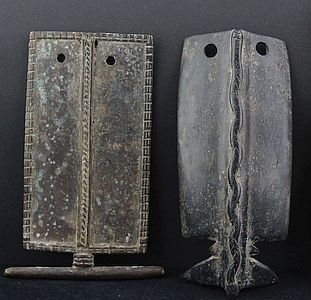

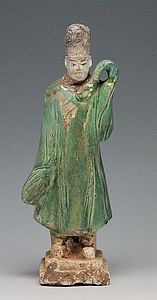
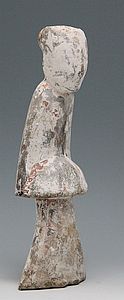
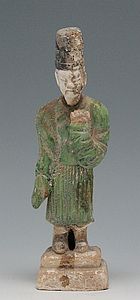
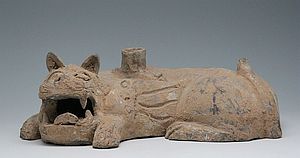

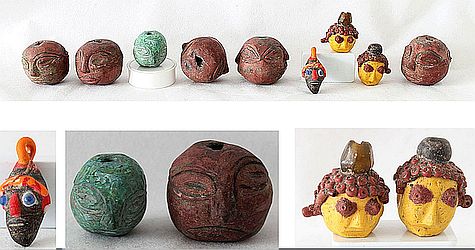

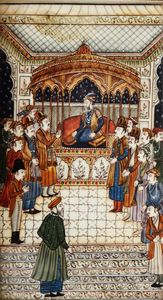
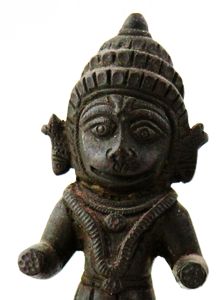
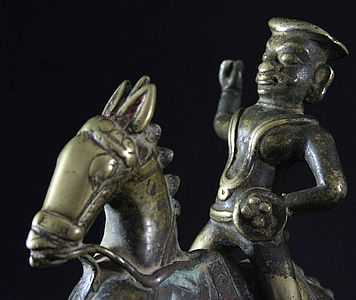 .
.
